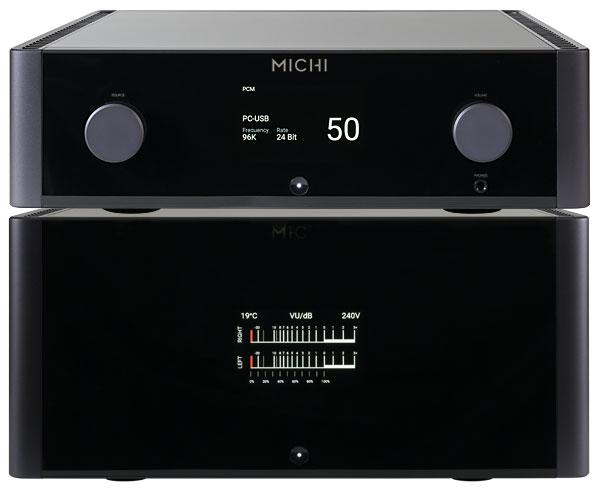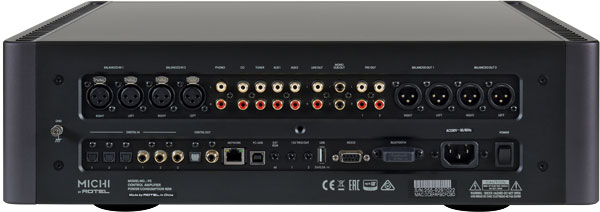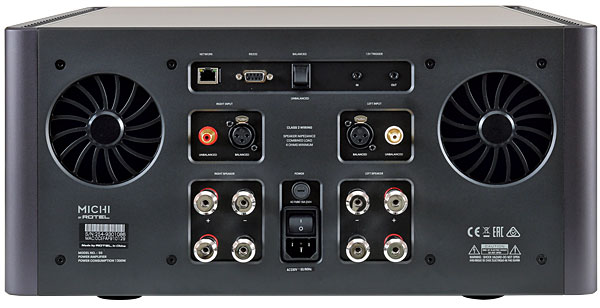Rotel Michi P5/S5 Pre/Power Amplifier

 A sleek new look heralds the return of Rotel's premier sub-brand, and its new control amplifier – or preamp – and stereo power amp have the wherewithal to succeed
A sleek new look heralds the return of Rotel's premier sub-brand, and its new control amplifier – or preamp – and stereo power amp have the wherewithal to succeed
Michi is back: last marketed in the 1990s, Rotel's elite sub-brand has rejoined the hi-fi fray after a three-year development project, and the establishment of a dedicated facility within the company's factory to hand-build the new products. And I have to admit to a pang of nostalgia for I reviewed the company's RHCD-10 player, slimline RHA-10 preamp and substantial RHB-10 power amp back in the dim and distant, and it was a case of lust at first listen, not to mention sight of the high-quality metalwork with its red-lacquered wooden side-cheeks.
Given how high the brand was riding at the time, with class-leading CD players and amplification, that meant the Michi line was, to these ears, very good indeed, and I'd convinced myself that if I ever had the money, I'd have a set in a heartbeat. And then Michi was gone, and we were back to best basic black Rotels. But it seems I wasn't alone in my affection for the range. To my eyes the styling hasn't dated, unlike so many designs of the time, and the fact that the original components are relatively scarce on the usual used platforms suggests those who bought into the range are hanging on to them.
Rotel Revival
Now, however, the brand has been revived under the auspices of Bowers & Wilkins, but Rotel remains a family-owned project. The initial offering, seen here, comprises the £3299 P5 'control amplifier' – or preamp – and 500W-rated S5 stereo power amp at £5399. There's also an exceptionally powerful M8 monoblock power amp, rated at 1080W/8ohm and 1800W/4ohm, and also selling for £5399. Except, of course, you'll need two for stereo.

These are all very much Michi products, but not 'Rotel Michi' for the M-word is the only branding you'll find on the gloss black fascias. And the styling is a very long way from the 'cooking' products coming out of the company's own purpose-built factory, on which production has concentrated for at least the past couple of decades.
Indeed, I'm tempted to suggest that the look isn't a million miles from that of the products of Canadian company Classé, which was part of the B&W fold until being adopted as part of the Sound United portfolio. I'm not suggesting there's any connection, but the simple fascia design with large displays and rounded edges subscribes to the same aesthetic – it's purposeful, and undeniably clean.
I first heard the new Michi products in action during the 2019 High End show in Munich, where B&W had the Michi amps driving its own 800 D3 speakers (we used the same, of course). Given the fact the demo was held in a huge penthouse with a high background level of conversation, what I heard was nonetheless sufficient to pique my interest. Not that I needed much piquing given my past affection for the Michi brand.
Fully Featured
So, what do we have here, now that the new Michis have landed? Well, the P5 is a very long way from those slender preamps of the past, both in looks and facilities. This is a full-featured preamp, designed to form the hub of a modern system, with both analogue and digital inputs, and the 'custom install' features to allow it to be integrated into a complete remote system.

For analogue sources, the P5 has two sets of balanced inputs, four line-ins on RCAs, and a switchable MM/MC phono stage. There's also one line out, two mono subwoofer outputs (which each output a summed signal from both channels), and a front-panel headphone output.
The digital provision is also generous. In addition to three optical and three coaxial digital inputs, the P5 has a USB-B port for connection to a computer, plus Bluetooth. A network port is also provided, but this is for control over IP and firmware updates, not network audio streaming, while the USB-A socket is only there to power external devices, and has no audio input capability. Other control options extend to a socket for a remote infrared sensor, 12V triggering, and serial RS232. Digital outputs are also provided on both optical and coaxial sockets.
The extensive menu system allows tone control configuration, or bypass, the setting of a fixed level on any input, and the renaming of those inputs. In addition, unused inputs can be turned off. MM/MC phono selection is also buried in these menus, which can be accessed from the front panel or via the slender metal-clad remote handset.
'Velvet Sound' DACs
Under the hood the P5 uses a pair of AKM DACs, allowing it to handle content up to 384kHz/32-bit, with DSD, DoP and MQA support via the USB-B connection. The analogue preamp section operates in Class A, the whole enterprise being powered by 17 regulated supplies hung off a pair of toroidal transformers. As is the way with Rotel, these transformers are custom-wound in-house in the company's Zuhai factory, and are both potted and placed right at the front of the P5, well away from the audio circuitry.























































